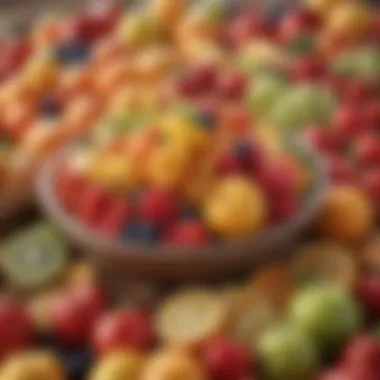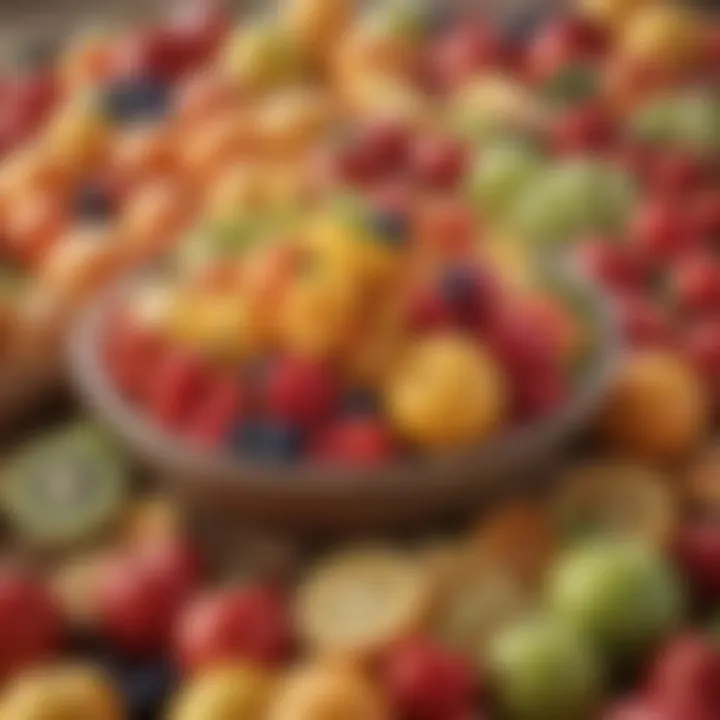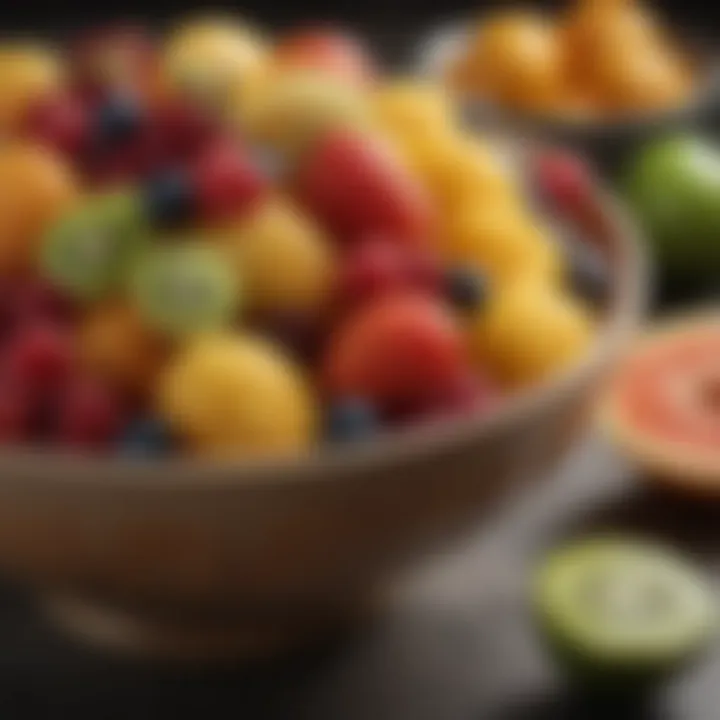The Value of a Budget-Friendly Fruit Bowl


Intro
In today’s world, where health and nutrition play a significant role in life, the concept of a cheap fruit bowl emerges as a practical and aesthetic solution for including fresh produce in our diets. A fruit bowl may seem mundane, yet it symbolizes an accessible way to enhance one’s culinary experience. This exploration serves a dual purpose: it not only illuminates the nutritional benefits of fruits but also addresses the affordable design choices that can be made when selecting a fruit bowl. By understanding this concept, home cooks and food enthusiasts can effectively incorporate a vibrant array of fruits into their lives while maintaining a careful budget.
A simple fruit bowl can propel one’s nutritional intake without incurring significant costs.
Fruit Bowl Significance
A cheap fruit bowl has vital importance in every kitchen, not just for its functionality. It encourages healthier eating habits by promoting easy access to fresh fruits. When displayed prominently in the kitchen or dining area, fruits become an attractive snack option, inspiring family members and guests to enjoy them instead of processed snacks. The aesthetic aspect of the fruit bowl cannot be overlooked; its design contributes to the overall ambiance of the space.
Nutritional Benefits of Fruits
Fruits are packed with essential vitamins, minerals, and fiber. They are a fundamental component of a balanced diet. By keeping a variety of affordable fruits in the bowl, individuals can ensure they receive diverse nutrients. *Common fruits to consider include bananas, apples, and oranges, as they are not only nutritious but also low in price throughout the year.*
Choosing the Right Fruits
When selecting fruits for affordability and nutrition, consider seasonal options. Seasonal fruits generally cost less and offer peak flavor and nutrients. Furthermore, some fruits have long shelf lives, reducing waste and enhancing convenience:
- Bananas
- Apples
- Pineapples
- Citrus fruits like oranges and grapefruits
These options can be chosen based on availability and personal preference, ensuring that the fruit bowl remains fresh and appealing.
Design and Aesthetic Appeal
The design of a fruit bowl plays a significant role in its effectiveness. Ideally, a fruit bowl should be both functional and visually inviting. It is essential to choose a style that complements the overall decor of the kitchen or dining area. A simple ceramic or wooden bowl can cut costs and add a natural element to the space. Consider the following aspects when selecting a fruit bowl:
- Material: Wood, ceramic, or glass can create different vibes.
- Size: Ensure enough space for variety without overcrowding.
- Shape: Round bowls are more traditional while unique shapes can stand out.
Sustainable Sourcing
When aiming for a cheap fruit bowl, it is also important to consider sustainability. Sourcing fruits from local farmers' markets not only supports local economies but also ensures that the fruits are fresher. Additionally, buying in bulk can lower costs and reduce packaging waste. Understanding the concept of sustainability aids consumers in making informed choices while shopping for produce, thereby contributing to a healthier environment.
Prelude to the Cheap Fruit Bowl
The concept of a cheap fruit bowl serves as a practical framework for integrating fresh produce into everyday life while remaining budget-conscious. With looming economic challenges, understanding how to maintain a fruit bowl that is both nutritious and affordable is essential. This article aims to highlight the significance of having a well-curated fruit bowl as a means of enhancing one’s diet.
A cheap fruit bowl is not just a vessel for fruits; it denotes a lifestyle choice that emphasizes health, accessibility, and sustainability. Fruits provide essential vitamins and minerals that are vital for overall well-being. Yet, the perception of healthy eating often comes with a higher price tag. By exploring the options available for creating an economical fruit bowl, readers can appreciate the benefits of fresh produce without feeling financially strained.
Consideration must also be given to subject of aesthetics in relation to a fruit bowl. The design of the bowl itself can influence how often individuals choose to consume the fruits it contains. An appealing fruit bowl serves not just as an item of decoration in the kitchen but as a constant reminder of the healthful choices within reach. Therefore, selecting the right bowl—both its material and design—can be important factors in ensuring that fruits are enjoyed regularly.
Moreover, accessibility cannot be overlooked. In diverse communities, the availability of certain fruits can vary dramatically. The article will explore local markets and cost-effective avenues to ensure that access to fresh fruits is feasible for everyone. In doing so, it aligns with larger goals related to public health and nutrition.
In summary, the concept of a cheap fruit bowl encapsulates much more than mere economics. It intertwines diverse aspects of life—from nutritional value and aesthetic choices to sustainability and accessibility. Through this exploration, readers will uncover effective strategies to make fresh, nutritious fruits a staple in their lives without stretching their budgets.
Nutritional Value of Fruits
The concept of a cheap fruit bowl extends beyond mere cost-effectiveness; it intertwines with the fundamental nutritional value of fruits. Understanding the essential aspects of the nutritional profiles of various fruits is critical. Nutrients such as vitamins, minerals, and fibers contribute significantly to overall health. Fruits are often celebrated for their high content of vitamins and low-calorie count, making them an essential part of even a tight budget.
Consumption of fruits provides an array of health advantages, particularly in disease prevention and overall vitality. They help maintain healthy bodily functions, support immune responses, and promote well-being when included regularly in meals. Incorporating fruits into a daily diet not only adds flavor but also enhances one's overall nutrient intake without overspending.
Overview of Essential Vitamins
Fruits are rich in essential vitamins critical for our bodies. Common vitamins found in fruits include Vitamin C, Vitamin A, and various B vitamins.
- Vitamin C is pivotal for its role in immune health. It also promotes skin health and aids in the absorption of iron from plant-based foods.
- Vitamin A, found in fruits like mangoes and apricots, is vital for maintaining vision and skin integrity.
- B vitamins, including B6 and folate, contribute to brain health and energy metabolism.
Each fruit holds specific vitamins in varying amounts, enriching one's diet with necessary nutrients. This reinforces the importance of selecting a diverse range of fruits for one's bowl, maximizing the health benefits available.


Health Benefits of Regular Fruit Consumption
Regularly consuming fruits is linked to numerous health benefits. These advantages arise from their high antioxidant properties, which help combat oxidative stress and reduce the risk of chronic diseases.
Research indicates that people who regularly include fruits in their diets tend to have lower chances of developing heart disease and are less prone to certain cancers. The dietary fiber in fruits assists in digestive health, promotes satiety, and may aid in weight management. Similarly, various phytonutrients in fruits contribute to improved cardiovascular health. As a result, including fruits in daily meals is not merely beneficial, it is a fundamental aspect of a health-conscious lifestyle.
Fruit as Part of a Balanced Diet
Fruits must play a vital role in a balanced diet. This notion encompasses not only how fruits complement other dietary components but also their integral relationship with overall food choices.
- Fruits can be paired with whole grains and lean proteins to create satisfying meals.
- Their natural sweetness can serve as healthier alternatives to processed snacks, minimizing added sugars and unhealthy fats.
- Incorporating fruits in breakfasts, snacks, or even dinners establishes well-rounded nutrition that supports not only physical health but mental clarity as well.
In summary, the nutritional value of fruits should not be underestimated. They provide essential vitamins, support health, and serve as a foundational element of a balanced diet. Engaging with a variety of fruits in a budget-friendly manner enriches both the culinary experience and personal well-being.
Selecting Fruits for Your Bowl
Selecting the right fruits for your bowl is crucial to not only ensure variety but also to maintain an affordable yet nutritious selection. The fruits you choose can have a significant impact on both taste and health benefits. Thoughtful choices can enhance your diet, making it more vibrant and enjoyable. This section will examine some important elements to consider while selecting fruits, including seasonal availability, whether to buy local or imported, and deciding between organic and conventional options.
Seasonal Fruit Choices
Seasonal fruits typically offer the best flavor, nutritional value, and cost-effectiveness. Consuming fruits in their peak season means they are harvested at the right time, ensuring maximum freshness. When selecting seasonal fruits, consider the following advantages:
- Flavor: Fruits grown in their natural season tend to be sweeter and richer in taste.
- Cost: Local markets often reduce prices during harvest times, making seasonal fruits more affordable.
- Nutrition: Fruits consumed soon after harvest preserve their vitamins and minerals better than out-of-season options.
Including a range of seasonal fruits in your bowl can keep your diet interesting. For example, strawberries and cherries in spring, peaches and blueberries in summer, apples and pears in fall, and oranges and kiwi in winter.
Local vs. Imported Fruits
The choice between local and imported fruits can affect both your wallet and your health. Local fruits are often fresher, as they do not spend extended periods in transport. Considerations include:
- Taste and Quality: Fruits from nearby farms often taste better, having been handpicked at their peak.
- Environmental Impact: Buying local typically results in a smaller carbon footprint since it reduces transportation emissions.
- Price: Local fruits may be more affordable when in season, as opposed to imports which can carry additional costs.
However, imported fruits can offer unique flavors that are not available locally. If diversity is a priority in your fruit bowl, both options can play a role in maintaining an exciting selection.
Organic vs. Conventional Fruits
The decision to choose organic or conventional fruits is increasingly important for health-conscious consumers. Organic fruits are grown without synthetic pesticides or fertilizers, which can be beneficial for health and the environment. Key factors to consider include:
- Health Benefits: Many people believe organic fruits are safer, less toxic, and potentially more nutritious. The use of chemical fertilizers is often limited, and organic practices can enhance soil health.
- Sustainability: Organic farming practices are designed to work with nature, potentially preserving biodiversity.
- Cost Difference: Organic fruits often cost more than conventional options, so weighing personal values against expenses is essential when selecting fruits for your bowl.
Cost-Effective Shopping Strategies
Effective shopping strategies play a crucial role in putting together a cheap fruit bowl. The right approach can lead to savings without compromising the quality of fruits. Seeking cost-effective methods allows you to enjoy a variety of fresh produce while staying within a budget. Moreover, these strategies often lead to healthier eating habits and increased awareness of where your food comes from.
Finding Local Farmers' Markets
Local farmers' markets offer an excellent opportunity to buy fruits at reduced prices compared to supermarkets. They connect consumers directly with growers and frequently have seasonal produce available. The freshness of fruits from these markets often surpasses that found in grocery stores. A visit to the farmer's market is not just about purchasing apples and bananas; it is a chance to explore unique and diverse fruit varieties, which might be more affordable.
Additionally, these markets promote community engagement. You may find valuable tips and recipes directly from the producers. Many vendors often have excess stock at the end of the day, leading to potential discounts. Therefore, shopping at local markets not only supports the economy but also results in savings on your fruit purchases.
Using Coupons and Discounts
Coupons and discounts are traditional yet effective ways to lower shopping costs. Many grocery stores and online retailers provide promotional offers for fruits. Familiarizing yourself with these deals can lead to substantial savings. For online shopping, you may register for newsletters that include special discounts. In-store apps also often feature exclusive deals on fruits.
Moreover, many supermarkets have loyalty programs that allow members to accumulate points with every purchase. These points can later be redeemed for discounts on future purchases. Planning shopping trips around sales events can maximize your savings while stocking your fruit bowl efficiently.
Choosing Bulk Purchase Options
Bulk purchasing can be an economical strategy for acquiring fruits. Buying in large quantities often reduces the price per unit. Use this strategy selectively, focusing on fruits that you consume regularly and those that have a longer shelf life. For instance, apples and oranges can last longer than berries, making them ideal bulk candidates.


When considering bulk purchases, evaluate whether you have sufficient storage space to avoid spoilage. Also, consider how quickly you can consume the fruits. Avoid buying excessive amounts of fruits that may not get eaten in time. In this way, choosing bulk options can be sustainable, cost-effective, and reduce the frequency of shopping trips.
Shopping wisely gives you more than food; it provides choice and sustenance.
Designing the Ideal Fruit Bowl
Creating an ideal fruit bowl is more than just choosing a container for fruits. The design can impact how often one reaches for healthy snacks and influences overall kitchen aesthetics. An attractive arrangement can entice family members to consume more fruits, contributing to better nutrition. Furthermore, thoughtful design considerations ensure the fruit is stored properly, extending its freshness and flavor.
Selecting the Right Bowl Material
The material of the bowl plays a vital role in its functionality and style. Options range from ceramic to wood, glass, or even metal. Each material has its own benefits:
- Ceramic: Often decorative, ceramic bowls can add color and texture to kitchen spaces. They are non-porous, making them easy to clean but can be heavy.
- Wood: Wood bowls provide a rustic charm. They are lightweight and add warmth but may require more care to avoid absorbing moisture and odors.
- Glass: Glass can showcase the fruits beautifully. However, it is fragile and needs careful handling.
- Metal: Sturdy and contemporary, metal bowls can be very functional. They resist breaking but might affect the ripening of certain fruits due to temperature conductivity.
Ultimately, the selection should align with personal taste and kitchen design, balancing aesthetics with practicality.
Size and Shape Considerations
The size and shape of the fruit bowl affect both its visual appeal and usability. A larger bowl encourages a variety of fruits, promoting a range of nutrients. On the other hand, smaller bowls may limit selection but keep the area tidy. Different shapes can also impact how fruits are arranged:
- Round bowls tend to promote a casual feel, ideal for every day.
- Square or rectangular bowls can work well for modern designs and are great for displaying multiple fruits.
Think about how the bowl fits into your kitchen flow and space. A well-placed bowl can serve both decorative and practical purposes.
Aesthetic Placement in the Home
Placement of the fruit bowl is crucial for both function and style. Consider locations that are easily accessible but also visually appealing. A bowl on the dining table encourages regular fruit consumption during meals, while a bowl on the kitchen counter allows quick snacks during cooking.
A few tips on placement include:
- Natural Light: Positioning the bowl in areas with indirect sunlight can enhance the color of the fruits, making the bowl more inviting.
- Visible Areas: Keeping the bowl in way where it can be seen encourages family members to pick fruits when passing through the kitchen or dining room.
- Avoiding Clutter: Ensure that the fruit bowl does not get lost among other kitchen items. A clear space boosts both functionality and aesthetics.
Creating the ideal fruit bowl involves more than just the selection of fruits. It’s about how the bowl fits into the overall home design and serves as a focal point for healthy eating choices.
The ideal fruit bowl can become a centerpiece in any kitchen. By considering material, size, shape, and placement, you ensure that it not only enhances the culinary experience but also supports a nutritious lifestyle.
Maintaining Your Fruit Bowl
Maintaining a fruit bowl is vital not only for aesthetic appeal but also for enhancing the longevity and nutritional value of the fruits it contains. A well-maintained fruit bowl can keep fruits fresher for longer and minimize waste. As fruits are perishable, understanding proper storage techniques and ripening processes is essential to get the most out of your cheap fruit bowl.
Best Practices for Storing Fruits
Storing fruits correctly is crucial to maintaining their flavor and texture. Here are some best practices:
- Separate Ethylene Producers: Some fruits, like bananas and apples, emit ethylene gas, which speeds up ripening in neighboring fruits. Keep them separate from sensitive fruits like berries and grapes.
- Store in a Cool, Dry Place: Most fruits prefer room temperature but should be kept out of direct sunlight. However, berries and certain grapes might benefit from refrigeration to maintain freshness.
- Use Ventilated Bowls: It is wise to use bowls that have air circulation. Bowls made from materials like wicker or mesh allow for better airflow compared to those made of plastic.
- Inspect Regularly: Checking for any signs of spoilage is essential. Remove any overripe or damaged fruit immediately to prevent them from affecting others in the bowl.
- Wash Before Consumption: While not a storage tip, washing fruits before eating helps in removing pesticides and dirt, adding to the overall healthiness of your fruit consumption.
Proper storage ensures that your fruits remain healthy and tasty, leading to overall better usage of your fruit bowl.
Understanding Fruit Ripening
Ripening is a natural process that affects how fruits taste and feel. Understanding this process can aid in better management of your bowl.
- Natural Ripening Process: Some fruits ripen off the plant, like tomatoes and avocados. It is essential to let these fruits reach their peak outside the fridge to develop flavor.
- Indicators of Ripeness: Look for a change in color or feel. A ripe avocado, for example, should yield slightly to gentle pressure, while ripe bananas show a bright yellow skin with possible brown spots.
- Speeding Up Ripening: If you have unripe fruits and wish to speed up the process, placing them in a paper bag with an ethylene gas producer, such as an apple, can help.
- Slowing Down Ripening: For fruits that ripen too fast, refrigerating them or keeping separate from ethylene producers can help prolong their freshness.
Maintaining a fruit bowl is not just about the selection of fruits but also about how they are cared for. The aspect of storage and ripening plays a significant role in the overall success of having a fruit bowl that is both functional and pleasing.
Sustainability in Fruit Selection


Sustainability in fruit selection plays a vital role in ensuring a balance between meeting dietary needs and protecting our environment. Consumers are becoming increasingly aware of the choices they make. The environmental impact of food production is significant, and fruits are no exception. Opting for sustainable fruit not only contributes to personal health but also aids in promoting practices that are better for the planet. Here are some key elements and considerations regarding sustainability in fruit selection:
- Environmental Footprint: The ecological impact of fruit farming includes land use, water consumption, and carbon footprint. By choosing locally sourced fruits, generally harvested and transported over shorter distances, consumers can reduce the overall environmental impact. This also supports emissions reduction during transportation.
- Pesticide Use: Organic fruits, while often more expensive, contain fewer synthetic pesticides and fertilizers. These chemicals can be damaging not only to the environment but also to human health. Consumers should be aware of the benefits of organic growing practices versus conventional methods.
- Biodiversity Conservation: Choosing a variety of fruits supports agricultural biodiversity. In turn, this encourages sustainable practices. Monoculture farming can lead to soil degradation and loss of natural habitats.
- Waste Reduction: Selecting fruits that are in season promotes efficiency in production and minimizes waste. In-season fruits are more readily available and are often sold at lower prices, reducing the likelihood of spoilage from transportation over long distances.
"Considering the sustainability of our food choices forms a vital aspect of a responsible lifestyle. It's not just about eating healthy, but also about making choices that keep our planet healthy."
Sustainable fruit selection goes hand-in-hand with how we choose and maintain our fruit bowls. Recognizing the importance of these considerations enhances not only dietary habits but also fosters a more eco-friendly lifestyle.
Impact of Food Waste
Food waste is a pervasive issue that has both economic and environmental ramifications. In the context of fruits, a significant portion of produce ends up in landfills. Reducing waste begins with thoughtful selection and storage methods. Here are some factors to consider:
- Proper Storage: Understanding how to store fruits helps extend shelf life and enhances quality. For instance, keeping apples in a cool, dark place can keep them fresh longer.
- Creative Usage: Finding ways to incorporate ripe or overripe fruits into meals can prevent waste. For example, overripe bananas make excellent smoothies or can be used for baking.
- Buying Smart: Purchasing only what you need within a manageable timeframe reduces the chance of spoilage.
By being mindful of food waste, individuals can maximize their budget while also contributing to sustainability efforts.
Supporting Local Farmers
Supporting local farmers is one of the most impactful choices consumers can make. This connection enhances the local economy and often aligns with sustainable practices. Here are some considerations regarding this:
- Fresh Produce: Fruits sourced from local farms are fresher and usually more nutrient-rich, as they have less time in transport. Direct access means that consumers can enjoy the peak flavor and supplies.
- Community Engagement: Buying from local farmers fosters a sense of community. It builds relationships and encourages consumers to understand their food sources better.
- Sustainable Practices: Many local farmers adopt organic and sustainable agriculture practices. By choosing to support them, consumers are endorsing these methods and contributing to the preservation of land and resources.
- Cultural Knowledge: Local farmers often have knowledge of regional fruits and can offer information about how to prepare and enjoy them. This can enhance the culinary experience.
Incorporating Fruits into Daily Meals
Incorporating fruits into daily meals offers numerous benefits, particularly when aiming for a balanced and nutritious diet. Fresh fruits are not only versatile but also packed with vitamins, minerals, and dietary fiber. This section dives into practical ways to integrate fruits throughout the day, demonstrating how they can contribute to overall health while appealing to the taste preferences of many.
Adding Fruits to Breakfast Options
Breakfast is often regarded as the most important meal of the day, and fruits can enhance this meal significantly. Adding fruits like bananas, berries, or apples to oatmeal or yogurt can introduce a delightful sweetness without added sugar. Consider smoothie bowls, where various fruits can be blended to create a refreshing start to the day.
- Bananas provide potassium and are an excellent topping for whole-grain cereals.
- Berries are rich in antioxidants and can be mixed with chia seeds and yogurt.
- Peaches or other seasonal fruits can brighten up a breakfast spread when added to pancakes.
Integrating fruits into breakfast not only boosts nutritional quality but also increases satisfaction and energy levels.
Fruits as Snacks
Transitioning to fruits as snacks entails a shift from processed and sugary options. Fresh fruits like apples, oranges, or grapes make convenient snacks that require minimal preparation. Sliced fruits, such as pears with nut butter, can satisfy cravings while being nutritious.
- Portable fruits like bananas or clementines are great for on-the-go snacking.
- Dried fruits like apricots or raisins can serve well as energy-boosting pouches.
- Fruit salad composed of a variety of fruits can be prepared and stored for quick access throughout the week.
This emphasis on fruits can aid in managing weight and improving overall health, steering individuals away from unhealthy snacking habits.
Creating Fruit-based Desserts
Turning fruits into desserts is an innovative way to indulge while still making health-conscious choices. Preparing desserts like fruit tarts or smoothies allows one to enjoy satisfying sweetness without the excessive calories of traditional desserts.
- Fruit compotes can serve as toppings for desserts like ice cream, providing a fresh flavor.
- Frozen fruit pops can be a delightful summer treat without additives.
- Baked fruits, such as apples with cinnamon, can yield comforting flavors on colder days.
Utilizing fruits in desserts not only enhances flavor profiles but also minimizes the use of refined sugars. The result is a lighter, more healthful treat that everyone can appreciate.
"Fruits can transform any meal and turn even the simplest dishes into culinary delights."
Integrating fruits into daily meals requires creativity and an understanding of their benefits. Through breakfast options, snack substitutions, and dessert innovations, the potential for incorporating fruits is vast and rewarding.
End
The conclusion of this article plays a vital role in synthesizing the multitude of concepts discussed around creating a cheap fruit bowl. It is essential to analyze not just the individual elements, but also the overall importance they contribute to health and budget efficiency. This section serves to encapsulate the journey from selecting fruits to designing and maintaining an aesthetically pleasing bowl.
One significant benefit of embracing the cheap fruit bowl concept is its accessibility. With practical strategies for cost-effective shopping, any individual, regardless of their economic status, can enjoy a variety of fruits without overspending. This accessibility fosters healthier eating habits that are achievable and sustainable.
Moreover, the emphasis on sustainability is critical. By choosing locally sourced and seasonal fruits, individuals can support their community while also reducing their carbon footprint. Understanding the impact of food waste ties into this as well; by being mindful of fruit selection and storage, a person contributes to a healthier planet.
The importance of incorporating fruits into daily meals cannot be overstated. Simple acts such as adding fruits to breakfast or using them in snacks can dramatically improve one’s nutritional intake. This continual engagement with fruits not only benefits physical health but also enhances overall culinary experiences.
In summary, this article's conclusion recaps the major themes that highlight the significance of a cheap fruit bowl. The focus is on nutrition, sustainability, and creativity in meal preparation, bringing forth an understanding of how an ordinary bowl can transform dietary habits and overall lifestyle choices.







